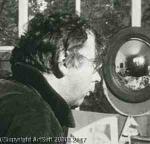Horst Janssen
Horst Janssen
Place: Hamburg
Born: 1929
Death: 1995
Biography:
Horst Janssen was a German draftsman, printmaker, poster artist and illustrator. He had a prolific output of drawings, etchings, woodcuts, lithographs and wood engravings.
Janssen was a student of Alfred Mahlau at the Landeskunstschule Hamburg. He first published in the newsweekly Die Zeit in 1947. In the early 1950s, he started working in lithography, on an initiative of Aschaffenburg paper manufacturer Guido Dessauer, using the technical facilities of a coloured paper factory. The first retrospective of Janssen's drawings and graphic works was shown in 1965, first in the kestnergesellschaft Hanover, then in other German cities and in Basel. In 1966, he was awarded Hamburg's Edwin Scharff Prize. International exhibitions followed. In 1968, he received the Grand Prize in graphic art at the Venice Biennale; in 1977, his works were shown at the documenta VI in Kassel.
The Horst Janssen Museum in his hometown of Oldenburg is dedicated to his legacy. His work is shown internationally in major museums.
His life was marked by numerous marriages, outspoken opinions, alcoholism, and selfless dedication to the art of printmaking.
Janssen was born in Hamburg. His mother, Martha Janssen, was a dressmaker from Oldenburg; he never knew his father. Janssen was brought up by his mother and grandparents at Lerchenstraße 14, Oldenburg. He was adopted by his grandfather, and following his death, he was adopted by the Guardianship Court in 1939.
In 1942, he became a student at the National Political Institute of Education (German: Nationalpolitische Erziehungsanstalt or napola) in Haselünne, Emsland, where an art teacher, Hans Wienhausen, encouraged his artistic talent. His mother died in 1943. In 1944, he was adopted by his mother's younger sister, Anna Janssen, and he moved to Hamburg, where she lived. He lived with his Aunt Anna on Burchardstraße for the remainder of the war and the postwar period. They later moved to Warburgstraße (Harvestehude). In 1946, at the age of sixteen, Janssen enrolled at the Landeskunstschule (regional art school) in Hamburg, where he studied with Alfred Mahlau, proving to be an outstanding pupil from the outset.
Janssen's first publication was a drawing in the weekly newspaper Die Zeit in 1947. The following year he published his first book, the children's book Seid ihr alle da? (Are you all there?), with Rolf Italiaander. In 1950 his first child, son Clemens, was born and he wrote and illustrated his second book, Der Wettlauf zwischen Hase und Igel auf der Buxtehuder Heide (The race between the hare and the hedgehog on the Buxtehude Heath), for the birthday of a little girl named Friederike Gutsche. It was published in a facsimile edition in 1973.
Janssen produced his first woodcuts, influenced by Edvard Munch. Dominant themes were animals along with man and woman. In 1952, he received a Lichtwark scholarship in Hamburg. Around the same time, he was forced to leave the Landeskunstschule. The following year, he was arrested after a drunken brawl and tried for murder. He was found innocent of the charge, but received a suspended sentence for drunkenness.
In the early 1950s, he received a commission from the paper manufacturer Guido Dessauer for a portrait of his father-in-law, the diplomat Friedrich von Keller, followed by other portraits of family members. Janssen was able to create his first lithographs using the technical equipment of the Aschaffenburger Buntpapierfabrik. His early lithographs were shown in 2000 by the Hamburger Kunsthalle. They included "Baumwall" (Tree Mound; 1957); his first self-portraits, such as "Selbst-innig" (Intimate with Self; 1966) and poster designs, influenced by Ben Shan, for his own exhibitions. Another self-portrait, "Selbst singend" (Self, singing), shows the artist with wide open mouth, as if expressing "tiefe Welt- und Gottesverzweiflung" (profound despair about the world and God), according to a reviewer. He changed a lithograph by Oskar Kokoschka, picturing himself upright, the other of two figures kneeling, titled "So liebt mich Oskar - Ja!" (Oskar loves me like that - Yes!). The exhibition also showed a piece,on which Janssen and his colleague André Thomkins had pictured each other, together with Thomkins' aphorism "Alles nicht wissen, heißt alles verzeihen" (To not know all means forgive all).
In 1955, he married Marie Knauer and in 1956, had a second child, a daughter, Katrin (nicknamed Lamme). During this period, he worked on a series of large-scale color woodcuts that were displayed in his apartment in 1957. Janssen gained recognition and had an exhibition in Hanover in the Hans Brockstedt Gallery in 1957. After this successful show, he suddenly switched to etching, becoming a pupil of Paul Wunderlich, whom he later considered a rival. His marriage to Marie ended in divorce in 1959. His art was now influenced by art brut and Jean Dubuffet. A new marriage, to Birgit Sandner, was followed by a separation a few weeks later. The following year, 1960, he married Verena von Bethmann Hollweg who, in 1961, gave birth to his third child, a son named Philip.
More...
Wikipedia link: Click Here




